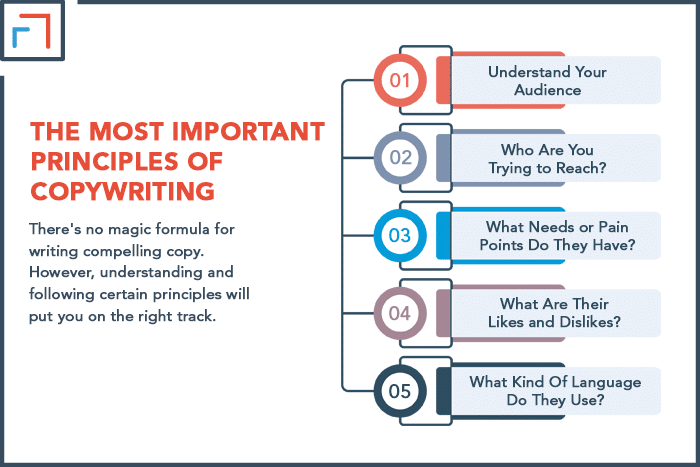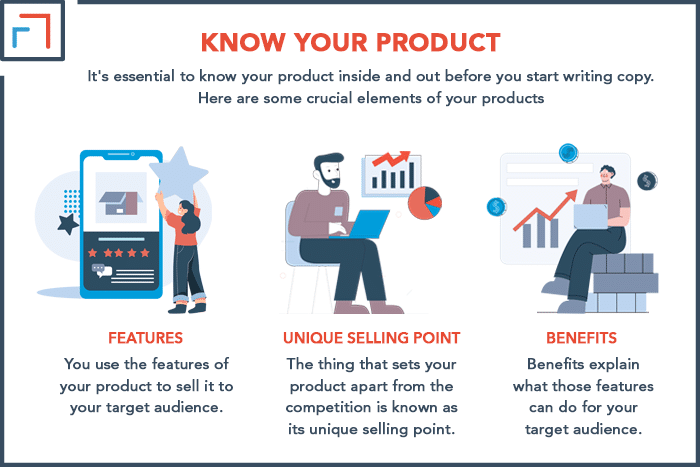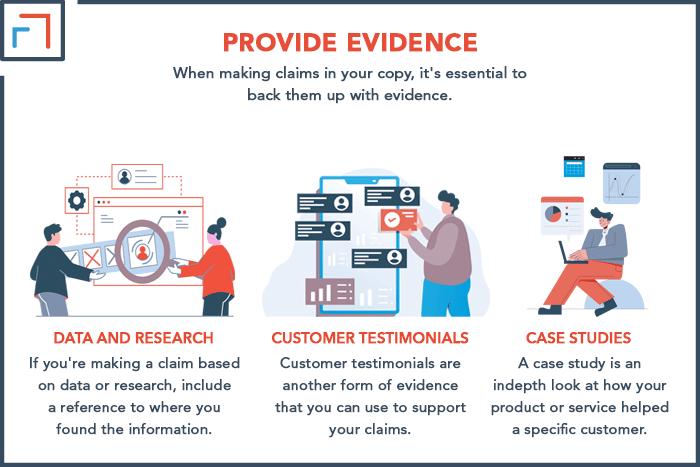Like any skill, copywriting takes practice to master. But understanding a few fundamental principles can help you write better copy. By definition, copywriting is the act of writing text for advertising or marketing a product.
Copywriting principles include understanding your audience, writing naturally, knowing your product, and having a CTA. Creating catchy headlines, being concise, and providing evidence to support your claims are other principles. If writers use these foundations, they can write about anything.
Now that we’ve given a brief overview of these principles let’s explore how writers can put them into practice. These elements will always apply to copywriting, no matter the topic.
The Most Important Principles of Copywriting
There’s no magic formula for writing compelling copy. However, understanding and following certain principles will put you on the right track.
1. Understand Your Audience
The first step in writing compelling copy is to understand your audience deeply. Ask yourself key questions like:
- Who are you trying to reach?
- What needs or pain points do they have?
- What are their likes and dislikes?
- What kind of language do they use?
Answering these questions will help you connect with your audience and write copy that resonates with them.
Who Are You Trying to Reach?
Creating buyer personas is a helpful way to get to know your target audience. A buyer persona is a collection of demographics, details, and information that represents your ideal customer.
It should be firmly grounded in market research and actual data about your existing customers. If you don’t have any data to go on, don’t worry.
You can still create a buyer persona using your best guesses and assumptions. The important thing is that you know who you’re writing for.
What Needs or Pain Points Do They Have?
Your target audience’s needs and pain points should be the driving force behind your copy. Copywriters should know about some of the key struggles customers face.
Ideally, the copy should focus on how your product or service can help them solve these problems. For example, let’s say you sell a natural sleep aid.
Your target audience might be people who have trouble falling asleep or staying asleep.
In your copy, you would want to focus on the benefits of your product, such as how it can help them get a good night’s rest.
What Are Their Likes and Dislikes?
Nothing turns away a potential customer more quickly than feeling like they’re being talked down to or sold to. That’s why it’s essential to know the likes and dislikes of your target audience.
For example, if you’re selling a luxury product, your prospects might respond better to formal and elegant copy.
On the other hand, if you’re selling a more casual product, your target audience might prefer friendly and down-to-earth copy.
What Kind Of Language Do They Use?
The language you use in your copy should be appropriate for your prospects. Most importantly, it should be easy for them to understand.
You might need to use more industry-specific jargon for a technical product. In contrast, if you’re selling a more general consumer product, you’ll want to use language that is more common and relatable.
By taking the time to understand your target audience, you can write copy that is more likely to resonate with them.

2. Write Naturally
The best copy is the kind that sounds like a conversation. It’s natural, relatable, and easy to read. That’s not to say that all copy needs to be written in a casual, conversational tone.
The tone of your content should match the style of your product or brand. Good copywriters avoid using industry jargon or acronyms that their target audience might not be familiar with.
Most importantly, don’t try to sound like something you’re not. Be authentic and write in your own voice. Having authority on the subject you’re writing about will also help make your copy sound more natural.
If you’re an expert on the topic, it will come across in your writing. If you’re not an expert, that’s also okay! Just ensure you do a lot of research and write from a place of knowledge.
Although conversion copywriting is essential, don’t sacrifice readability for the sake of conversions. Your goal should be to write copy that is both informative and enjoyable to read.
If your copy is a slog to get through, chances are your target audience won’t stick around long enough to convert.
3. Know Your Product
Although it might seem like an obvious point, it’s essential to know your product inside and out before you start writing copy.
Here are some crucial elements of your products which should be at your fingertips:
- Features
- Unique selling point (USP)
- Benefits
Features
These are the specific characteristics of your product. For example, some essential camera features might be its megapixel count or video quality.
You use the features of your product to sell it to your target audience. So, in your copy, you’ll want to focus on the features that are most important to them.
Each feature should have a benefit that your target audience will care about. It’s not enough to simply list the features of your product.
You should be able to show how those features will improve their life or solve their problem.
Unique Selling Point (USP)
The thing that sets your product apart from the competition is known as its unique selling point.
Your USP is what makes your product special and worth buying. It’s the thing that will convince your prospects that your product is the best solution to their problem.
When writing copy, be sure to highlight your USP. This showcases why people should buy from you and not the competition.
Benefits
Don’t confuse features with benefits. Features are the characteristics of your product. Benefits explain what those features can do for your target audience.
For example, a benefit of a high megapixel count is that it results in clear, quality photos.
The benefits of your product should be front and center in your copy. After all, your target audience doesn’t care about the complex features; they care about what your product can do for them.
Some products will have more obvious benefits than others.
If you’re having trouble identifying the benefits of your product, ask yourself this question: How does this product improve my target audience’s life?
By asking this question, you can identify the specific benefits that your product offers.

4. Have a Call to Action (CTA)
Your CTA is what you want your target audience to do after they read your copy. You might want them to:
- Buy your product
- Sign up for your email list
- Download a white paper
- Subscribe to your course
Whatever it is, make sure your CTA is clear, specific, and easy to follow. Your CTA should be visible and stand out from the rest of your copy. Use actionable language and make it as straightforward as possible.
It is advisable that you only have one CTA per page. Multiple CTAs can be confusing and will likely result in lower conversion rates.
A salesy or pushy copy is a turn-off for most people. Instead of using forceful language, try to appeal to your target audience’s emotions.
A call to action doesn’t mean you should overhype your product. Be sincere, transparent, and honest about what you’re offering.
5. Catchy Headlines
Your headline is the first thing your target audience will see. Therefore, it’s important to make a good impression.
The headline should be clear, concise, and to the point. It should also be interesting and relevant to your target audience. Avoid jargon or technical terms that might be unfamiliar to your target audience.
Instead, use simple language that is easy to understand. Here are a few tips on how you can make your headlines appealing to your target audience:
- Use numbers: People are drawn to headlines with numbers because they are easy to digest and understand. For example, “The Top 12 Copywriting Tips for Beginners.”
- Use emotional words: Emotional words can be powerful in getting people’s attention. Some examples include: “Amazing,” “Incredible,” “Life-Changing,” etc.
- Create curiosity: A curiosity-inducing headline can effectively get people to read your copy. For example, “You Won’t Believe What This Product Can Do!”
There is no perfect formula for writing headlines. However, following these tips can increase the chances of getting people to read your copy.
Be creative and experiment with different headlines until you find the one that works best for your target audience.
6. Simplicity and Conciseness
Complexity is the enemy of clarity. Therefore, when writing copy, always aim for simplicity and conciseness.
Your target audience should be able to understand your message without any difficulty. Don’t use big words or complex jargon for the sake of it.
This approach will turn people away instead of drawing them in. It’s also important to be concise in your writing. Get straight to the point and avoid rambling.
People hate to read lengthy introductions that don’t tell them anything useful. Your copy should be easy to read and understand.
Use short sentences and paragraphs, and break up your text with subheadings. Large blocks of text can be intimidating and hard to read, so provide plenty of breaks and white space.
7. Provide Evidence
When making claims in your copy, it’s essential to back them up with evidence.
Whether you’re claiming that your product is the best on the market or that it can help people save time, you must provide evidence to support your claims.
Data and Research
If you’re making a claim based on data or research, include a reference to where you found the information. Making baseless claims will damage your credibility.
Credible information sources include:
- Academic journals
- Government reports
- Industry publications
- Peer-reviewed studies
If you’re using data from another source, cite it properly. Plagiarism is a serious offense, and it can damage your reputation.
Customer Testimonials
Customer testimonials are another form of evidence that you can use to support your claims. You can include satisfied customer testimonials in your copy to show that your product or service is effective.
When using customer testimonials, you may want to include:
- Customer’s name
- Title or position
- A link to their website or social media profile (if available)
- Video or image
In an era where companies are buying fake reviews, it’s important to use testimonials from genuine customers only. Make sure you get permission from customers before using their reviews, though!
Case Studies
There are few things more convincing than a case study. A case study is an in-depth look at how your product or service helped a specific customer.
When writing a case study, you should include:
- The problem the customer was facing
- How your product or service helped solve the problem
- Specific results achieved by the customer
When writing a case study, tell a story your prospects can relate to. The more relatable the story, the more likely it is that your copy will convince them.

8. Write Scannable Copy
With our average attention spans decreasing, writing easily scannable copy is advisable. Scannable copy is easy to read and understand, even if you only look at the major points.
It’s not full of long paragraphs or dense blocks of text. Prospects usually don’t read online content word for word. They tend to skim through it, looking for specific information.
By making your copy scannable, you increase the chances of people finding the information they’re looking for.
Here are some tips for writing scannable copy:
- Write short sentences and paragraphs
- Use on-topic subheadings to break up your text
- List information with bullet points
- Bold or highlight text with important information
- Add images and infographics
9. Editing
After you’ve written your copy, proofreading it is crucial. Read through your text and look for any errors or typos. These small mistakes can make you look unprofessional and will damage your credibility.
It’s also essential to check your grammar and spelling. Once you’ve edited your copy, have someone else read it over. Another set of eyes can help you catch any mistakes you may have missed.
By taking the time to review your copy before sharing it, you can avoid making costly mistakes. You can also use this time to ensure your message is clear and concise.
There are various tools you can use to help you revise and edit your copy, such as:
- Grammarly: If you’re not a native English speaker or want help catching errors, Grammarly is a great tool. It’s an AI-powered writing assistant that can help you improve your grammar and spelling.
- Hemingway Editor: This tool highlights lengthy, complex sentences and common errors. It also gives your text a readability score, which is the average level of education someone would need to understand your copy.
Error-free copy shows that you’re professional and care about the quality of your work.
10. Brainstorm New Approaches
Copywriting is a dynamic field, and new ideas are constantly emerging. To stay ahead of the curve, you need to be open to trying new things.
One way to do this is to keep up with the latest copywriting trends. This way, you’ll know what’s working for other businesses and can adapt these strategies for your projects.
You can also engage with other professionals in the industry to learn new techniques. And, if you’re ever stuck, don’t be afraid to ask for help from a more experienced copywriter.
Trial and error is also a great way to learn. If unsure about something, test it out and see what happens. The worst that can happen is that it doesn’t work, and you’ll know not to do it again.

Final Thoughts
The foundation of the copywriting industry is its principles. You can create persuasive, effective, and error-free marketing materials by following copywriting principles.
When writing copy, keep your audience in mind, write naturally, know your product inside out, have a call to action, and ensure your headlines are catchy.
Your copy should also be simple, provide verifiable evidence, and be scannable. Always review your work before sharing it and try new ideas to stay ahead of the curve.
